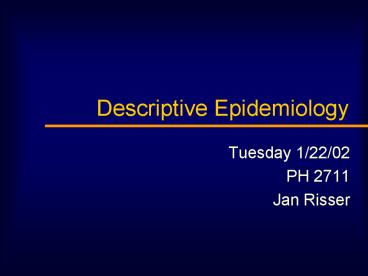Descriptive Epidemiology - PowerPoint PPT Presentation
1 / 32
Title:
Descriptive Epidemiology
Description:
From: A Dictionary of Epidemiology. Fourth Edition. John M Last. Descriptive Epidemiology ... Urban vs. Rural. Migrant studies. Study of migrants. Time ... – PowerPoint PPT presentation
Number of Views:2558
Avg rating:5.0/5.0
Title: Descriptive Epidemiology
1
Descriptive Epidemiology
- Tuesday 1/22/02
- PH 2711
- Jan Risser
2
Descriptive Epidemiology
- The study of the occurrence of disease or other
health-related characteristics in human
populations by - Age
- Sex
- Race
- Occupation
- Social class
- Geographic location
- From A Dictionary of Epidemiology. Fourth
Edition. John M Last
3
Descriptive Epidemiology
- The major characteristics in descriptive
epidemiology can be classified under the
headings - Person
- Place
- Time
4
Descriptive Epidemiology
- Concerned with the study of the distribution of
disease in population groups - Systematic summary of the basic data on health
and the major causes of disease and death
5
Descriptive Epidemiology
- Objectives
- to summarize trends in health
- to compare groups
- to provide a basis for planning, provision, and
evaluation of health services - to identify problems to be studied by analytic
methods
6
Distribution
- When distribution of rates is not uniform
according to person, place, and time - Epidemiologists can identify high-risk groups
- often for prevention purposes
- Generate causal hypotheses
- based on agent-host-environment paradigm
7
Person
- Age
- Sex (biological parameters)
- Gender (social parameters)
- race/ethnicity
- Education
- Socio-economic Status
8
Descriptive Epidemiology
- Person
- Age often the most important determinant among
personal characteristics - Sex differences in morbidity and mortality.
- Males have higher mortality
- Females have higher morbidity
- Race/ethnicity
- Is this a proxy for socio-economic status?
9
Death rate per 100,000. 1980-1998 TexasBy Age
and by Sex
10
Suicide rate per 100,000. 1980-1998 Texas By
sex and age.
11
Emphysema and Bronchitis rates per 100,000.
1980-1998 Texas. By sex and age
12
Pertussis
Scarlet Fever
Diphtheria Meningitis Polio
Rubella
Mumps Chickenpox
13
Race/ethnic
- How to classify and for what purpose
- Genetics
- Cultural factors
- Proxy for socio-economic status
- Social class
- Prestige
- Wealth
- Power
14
Race/ethnicity
- Prior to 1970 census was classified as
- White
- All others (all non-whites)
- Non-whites had marked disadvantage with respect
to mortality which still persists - These differences may represent differences
associated with the environment
15
Race/ethnicity
- 1970 Census
- White, non-White
- 1980 and 1990 Census 16 categories 2 write in
- American Indian/Alaskan Native/Aleut
- Asian or Pacific Islander
- White, Black
- Hispanic and Not Hispanic
- 2000 Census 15 categories 3 write-in more
than 1 answer
16
Race/ethnicity
- 2000 Census
- American Indian or Alaska Native
- Asian Asian Indian, Chinese, Filipino,
Japanese, Korean, Vietnamese - Pacific Islander Native Hawaiian, Guamanian or
Charmorro, Samoan, Other Pacific Islander - White
- Black
- http//www.census.gov/dmd/www/pdf/d61a.pdf
17
Race/ethnicity
- Prestige
- Wealth
- Power
- Social Class
- Occupation
- Marital status
- Nativity
- Family size
- Birth order
- Maternal age
- Parental Deprivation
18
Mortality by social class in England and
Wales1949 - 1953
SMR ratio for entire population of males aged
20-64 Infant mortality per 1000 live births
19
Dental health by family income
Filled Teeth
Decayed Teeth
20
Place
- Natural and political boundaries
- Urban/rural
- International Comparisons
- Migrants
21
(No Transcript)
22
Urban vs. Rural
23
Migrant studies
- Study of migrants
24
Time
- Secular trends
- changes over a long period of time
- Cyclic changes
- Recurrent alterations in the frequency of disease
- Clusters
- Cohort analysis
25
Analysis birth cohort
Does the prevalence of disease decline with age?
26
Analysis birth cohort - Survey date
27
Analysis birth cohort
28
Analysis birth cohort
1960
1950
1920
1940
1930
29
Deaths from TB
30
Death from TB
31
Deaths from TB
32
TB by Birth Cohort






























